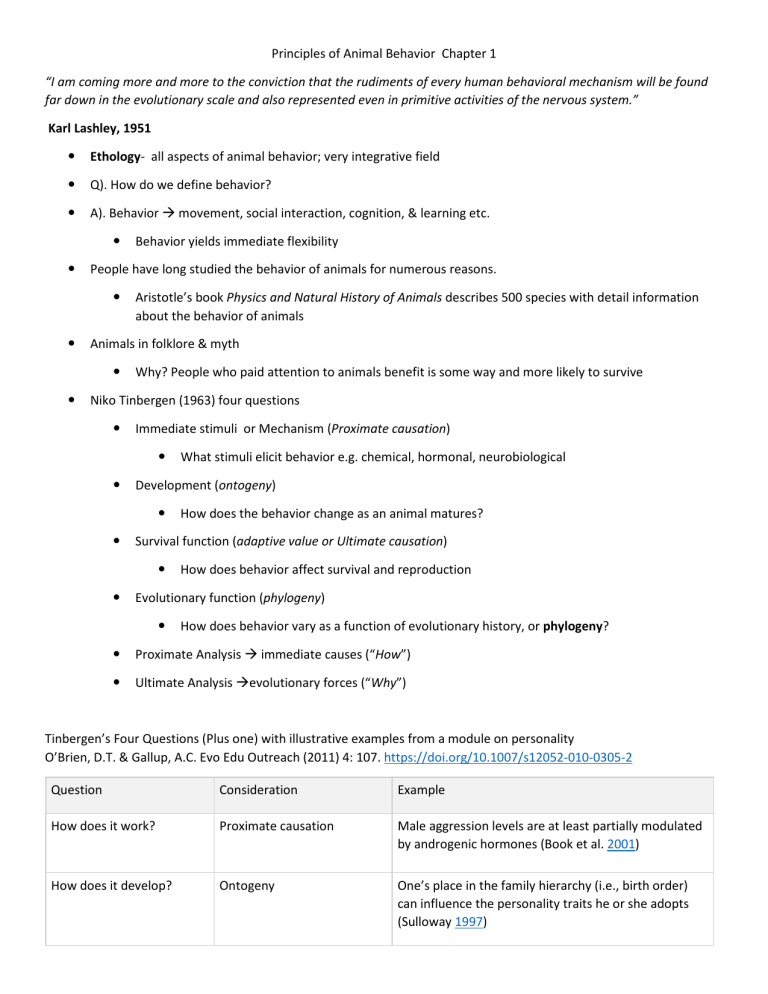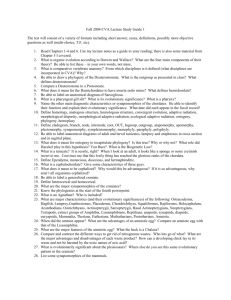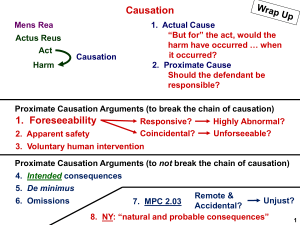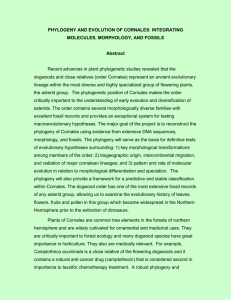
Principles of Animal Behavior Chapter 1 “I am coming more and more to the conviction that the rudiments of every human behavioral mechanism will be found far down in the evolutionary scale and also represented even in primitive activities of the nervous system.” Karl Lashley, 1951 ’ Ethology- all aspects of animal behavior; very integrative field ’ Q). How do we define behavior? ’ A). Behavior movement, social interaction, cognition, & learning etc. ’ ’ People have long studied the behavior of animals for numerous reasons. ’ ’ Aristotle’s book Physics and Natural History of Animals describes 500 species with detail information about the behavior of animals Animals in folklore & myth ’ ’ Behavior yields immediate flexibility Why? People who paid attention to animals benefit is some way and more likely to survive Niko Tinbergen (1963) four questions ’ Immediate stimuli or Mechanism (Proximate causation) ’ ’ Development (ontogeny) ’ ’ How does the behavior change as an animal matures? Survival function (adaptive value or Ultimate causation) ’ ’ What stimuli elicit behavior e.g. chemical, hormonal, neurobiological How does behavior affect survival and reproduction Evolutionary function (phylogeny) ’ How does behavior vary as a function of evolutionary history, or phylogeny? ’ Proximate Analysis immediate causes (“How”) ’ Ultimate Analysis evolutionary forces (“Why”) Tinbergen’s Four Questions (Plus one) with illustrative examples from a module on personality O’Brien, D.T. & Gallup, A.C. Evo Edu Outreach (2011) 4: 107. https://doi.org/10.1007/s12052-010-0305-2 Question Consideration Example How does it work? Proximate causation Male aggression levels are at least partially modulated by androgenic hormones (Book et al. 2001) How does it develop? Ontogeny One’s place in the family hierarchy (i.e., birth order) can influence the personality traits he or she adopts (Sulloway 1997) Why does it work? Ultimate causation (Adaptive value) Extroverts have more mating success, but also run extra risks, selecting for a balance between extro- and introversion (Nettle 2005) How did it evolve? Phylogeny Aspects of the dopamine system modulate sensation seeking across the animal kingdom (see Fidler et al. 2007 for evidence and a short review) What role does culture play? Culture A more structured society may have selected for genes that code for lower extroversion and impulsivity in China (Chang et al. 1996) Immediate stimuli or mechanism (causation) Development (ontogeny) Survival (adaptive value) Evolution (phylogeny) Culture? 1. How & why do human infants cry? 2. How & why do dogs exhibit social behaviors with humans? 3. How & why do rooster crow early in the morning? 4. How & why do salmon swim back to the freshwater site that they were hatched? Three Foundations 1. Natural Selection 1. EX) Crickets & naked mole rats 2. Individual Learning 1. EX) Birds & grasshoppers 3. Cultural Transmission 1. Rats Natural Selection Process by which traits that confer the highest relative reproductive success (relative fitness) on their bearers and that can be passed down across generations increase in frequency over many generations (evolutionary time). Darwin recognized that natural selection applied to behavioral traits as well as anatomical, morphological, and developmental traits. EXAMPLE: Zuk et al. (2006) • Is there a trade-off between song production and parasitism? • N.A. crickets are parasitized by flies. The song that attracts females also attracts the flies. • Less singing was heard over time. Where the crickets becoming extinct on the islands of Hawaii? • Finding: the number of “flatwing” males increased. Flatwing males were also attracted to the song of maleswhy? EXAMPLE Spinks et a. (1998) ’ Examined Xenophobia in the common moles rat. ’ Genetically related colonies with one pair of reproducing individuals. ’ Do the resources in the environment (rich vs poor) influence xenophobia? ’ Natural selection should favor xenophobia based on the sex of the individual. Individual Learning ’ ’ Can female birds change their mating behavior (mate choice) as a result from personal experience? ’ Natural selection may favor the ability to learn which may alter subsequent behavior in the individual. ’ Natural selection could change the frequency of different learning rules across generations. Dukas & Bernays (2000) examined the fitness-related benefits of learning. ’ Can grasshoppers learn to associated cues (color & odor) with a balanced diet and a deficient diet and what are the benefits? ’ Yes! Grasshoppers in the learning condition visited the balanced diet more often, feed more from the balanced diet, and grew more than those in the random condition. Cultural Tansmission ’ Social learning- situations in which animals copy the behavior of others ’ Galef & Wigmore (1983) ’ What do rats do when confronted with a new food resource? ’ Tested the information-centered hypothesis- that foragers may learn critical pieces of information from interacting with those who have returned from foraging. ’ Choose 2 novel flavors (cocoa & cinnamon). ’ Allowed the observer rats to interact with a demonstrator rat who had recently eaten the cocoa. Two days later, test the observer rats with the novel flavor. Do rats prefer cocoa or cinnamon Examples of Approaches ’ ’ ’ Conceptual ’ Integrating formerly unconnected ideas and combining in new cohesive way ’ EX) Hamilton’s ideas on kin selection- natural selection doesn’t just favor that individual but also closely related kin Theoretical ’ Generates a mathematical model ’ EX) Cheetah foraging and prey value Empirical ’ ’ Gathering data, drawing conclusions, generating new testable predictions. ’ Observational studies ’ Experimental studies EX) Red-wing blackbird foraging under predation pressure




